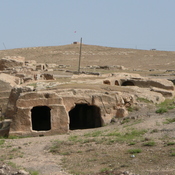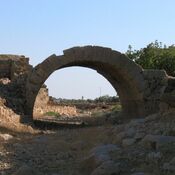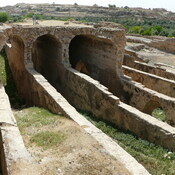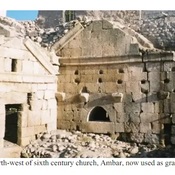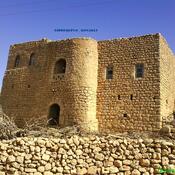Lage:
- Türkei, Oğuz
- geo:37.178329,40.947384
- Lage ± 0-5 m.
Period or year:
- 505~ / unknown
Klassification:
- Stadt
- Sichtbar
Identifiers:
- vici:place=11999
- wikidata:entity=Q585145
Anmerkungen
The city, known as Dara, is referred in ancient Greek sources as “Daras”. It was first mentioned by ancient author Iustinus Frontinus. According him the city founded by the King Arsaces I of Parthia (247 BC to 217 BC). Unti the first century BC Dara was in Arsacid Empire and Sasanian Empire. Later it became a Roman city from 620 AD to AD 639. It was East Roman fortress in northern Mesopotamia on the border with the Sassanid Empire. In 640 AD came into Arab domination.
Procopius: When the Persians retired from the territory of the Romans, selling to them the city of Amida, as I have related in the Books on the Wars, the Emperor Anastasius selected a hitherto insignificant village close to the Persian boundary, Daras by name, and urgently set about enclosing it with a wall and making it into a city which should serve as a bulwark against the enemy. But since it was forbidden in the treaty which the Emperor Theodosius once concluded with the Persian nation, that either party should construct any new fortress on his own land where it bordered on the boundaries of the other nation, the Persians, citing the terms of the peace, tried with all their might to obstruct the work, though they were hard pressed by being involved in a war with the Huns. So the Romans, observing that they were for this reason unprepared, pressed on the work of building all more keenly, being anxious to get ahead of the enemy before they should finish their struggle with the Huns and come against them. Consequently, being fearful by reason of suspicion of the enemy, and continually expecting their attacks, they did not carry out the building with care, since the haste inspired by their extreme eagerness detracted from the stability of their work. For stability is never likely to keep company with speed, nor is accuracy wont to follow swiftness. They therefore carried out the construction of the circuit-wall in great haste, not having made it fit to withstand the enemy, but raising it only to such a height as was barely necessary; indeed they did not even lay the stones themselves carefully, or fit them together as they should, or bind them properly at the joints with mortar. So within a short time, since the towers could not in any way withstand the snows and the heat of the sun because of their faulty construction, it came about that the most of them fell into ruin. So were the earlier walls built at the city of Daras........1.
Sources:
- https://infogalactic.com/info/Dara_(Mesopotamia)
- https://en.wikipedia.org/wiki/Dara_(Mesopotamia)
- Zacharias of Mytilene, Syriac Chronicle, Book VII, Chapter VI
- Procopius, De Aedificiis, Book II
Referenzen
In der Nähe
Iustiniana Nova [Dara] Great Church
Justinian church
St Bartholomew Church, Iustiniana Nova [Dara]
Justinian church.
Dara [Mesopotamia]
Necropolis of ancient Daras



